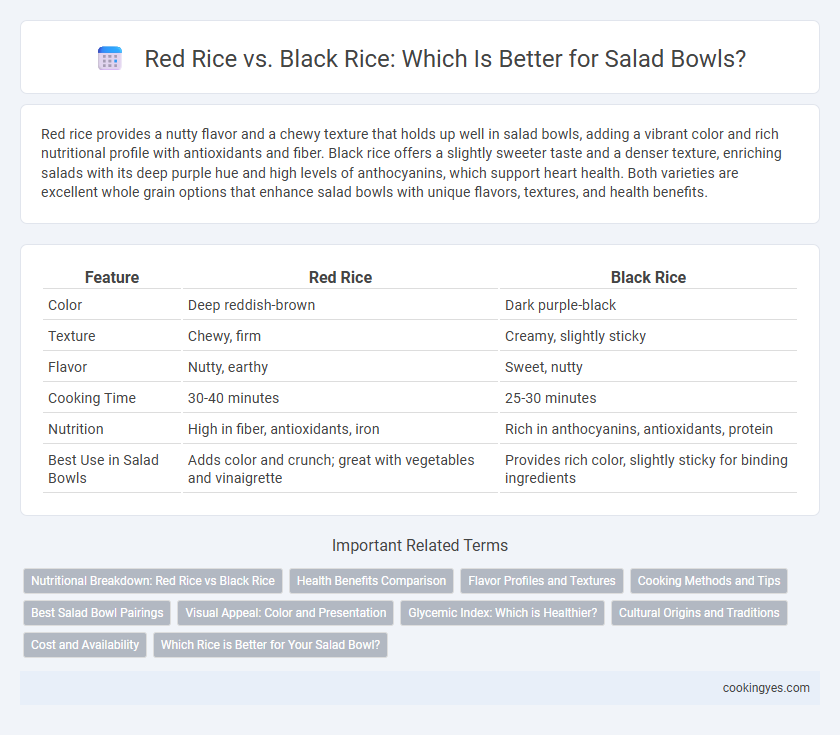Red rice provides a nutty flavor and a chewy texture that holds up well in salad bowls, adding a vibrant color and rich nutritional profile with antioxidants and fiber. Black rice offers a slightly sweeter taste and a denser texture, enriching salads with its deep purple hue and high levels of anthocyanins, which support heart health. Both varieties are excellent whole grain options that enhance salad bowls with unique flavors, textures, and health benefits.
Table of Comparison
| Feature | Red Rice | Black Rice |
|---|---|---|
| Color | Deep reddish-brown | Dark purple-black |
| Texture | Chewy, firm | Creamy, slightly sticky |
| Flavor | Nutty, earthy | Sweet, nutty |
| Cooking Time | 30-40 minutes | 25-30 minutes |
| Nutrition | High in fiber, antioxidants, iron | Rich in anthocyanins, antioxidants, protein |
| Best Use in Salad Bowls | Adds color and crunch; great with vegetables and vinaigrette | Provides rich color, slightly sticky for binding ingredients |
Nutritional Breakdown: Red Rice vs Black Rice
Red rice contains high levels of anthocyanins and iron, supporting antioxidant properties and improved blood health, while providing fiber, magnesium, and manganese essential for digestion and metabolism. Black rice, rich in anthocyanins and higher in protein and vitamin E, offers potent antioxidant benefits and promotes heart health and skin vitality. Both varieties contribute complex carbohydrates and essential minerals, but black rice typically holds a slight edge in protein content and antioxidant concentration, making it a nutrient-dense choice for salad bowls.
Health Benefits Comparison
Red rice contains high levels of antioxidants like anthocyanins and iron, which support heart health and improve blood circulation. Black rice offers superior amounts of fiber and vitamin E, promoting digestion and skin health while also reducing inflammation. Both varieties provide complex carbohydrates and essential minerals, making them nutritious options for salad bowls.
Flavor Profiles and Textures
Red rice has a nutty flavor and a slightly chewy texture, adding earthiness and bite to salad bowls. Black rice offers a mildly sweet, almost blackberry-like taste with a denser, more tender texture that contrasts well with crisp vegetables. Both varieties provide antioxidant-rich pigments and complement fresh, vibrant salad ingredients with distinct taste and mouthfeel.
Cooking Methods and Tips
Red rice requires a longer cooking time, typically 40-50 minutes, and benefits from soaking for at least 30 minutes to enhance texture and reduce cooking time. Black rice cooks in approximately 30-35 minutes and retains a slightly chewy texture, making it ideal for salads that require a firmer grain. Both red and black rice pair well with a gentle rinse before cooking to remove excess starch and can be cooled quickly by spreading on a baking sheet for perfect salad bowl consistency.
Best Salad Bowl Pairings
Red rice offers a nutty flavor and firm texture that pairs well with robust vegetables and tangy dressings, enhancing the heartiness of salad bowls. Black rice, known for its slightly sweet taste and chewy consistency, complements fresh fruits, nuts, and citrus-based vinaigrettes, adding both color and nutritional value. Both grains provide rich antioxidant properties, making them excellent choices for nutrient-dense, visually appealing salad bowls.
Visual Appeal: Color and Presentation
Red rice offers a warm, earthy hue that enhances salad bowls with a rich, natural vibrancy. Black rice provides a striking deep purple-black color that creates bold, dramatic contrasts in presentations. Both varieties add unique visual appeal, elevating the overall aesthetic of salad bowls and enticing appetites through colorful, wholesome ingredients.
Glycemic Index: Which is Healthier?
Red rice has a glycemic index (GI) typically ranging from 50 to 55, making it a low to medium-GI food that helps maintain stable blood sugar levels. Black rice has an even lower GI, often between 42 and 45, due to its higher fiber content and antioxidant profile, which can contribute to better glycemic control. Choosing black rice for salad bowls is generally healthier for managing blood glucose, especially for individuals with insulin sensitivity or diabetes.
Cultural Origins and Traditions
Red rice, originating from Southeast Asia, holds significant cultural importance in regions like Bhutan and Thailand where it is traditionally used in festive and everyday dishes, prized for its nutty flavor and rich fiber content. Black rice, historically known as "forbidden rice" in ancient China, was once reserved for royalty due to its high antioxidant properties and deep cultural symbolism tied to health and longevity. Both varieties offer unique textures and flavors that enhance salad bowls, reflecting their distinct heritage and nutritional profiles.
Cost and Availability
Red rice and black rice both offer unique flavors and nutritional benefits for salad bowls, but their cost and availability differ significantly. Red rice tends to be more widely available and affordable, commonly found in grocery stores and markets, making it a popular choice for budget-conscious consumers. Black rice, often considered a specialty grain, usually has a higher price point and limited availability, which can affect its accessibility for regular use in salads.
Which Rice is Better for Your Salad Bowl?
Red rice offers a robust, nutty flavor and a chewy texture that enhances salad bowls with high fiber and antioxidant content. Black rice provides a slightly sweeter taste and a dense, nutrient-rich profile, including anthocyanins that boost heart health and reduce inflammation. Choosing between red rice and black rice depends on desired taste and nutritional goals, with red rice favoring earthiness and black rice delivering superior antioxidant benefits.
Red rice vs Black rice for salad bowls Infographic

 cookingyes.com
cookingyes.com